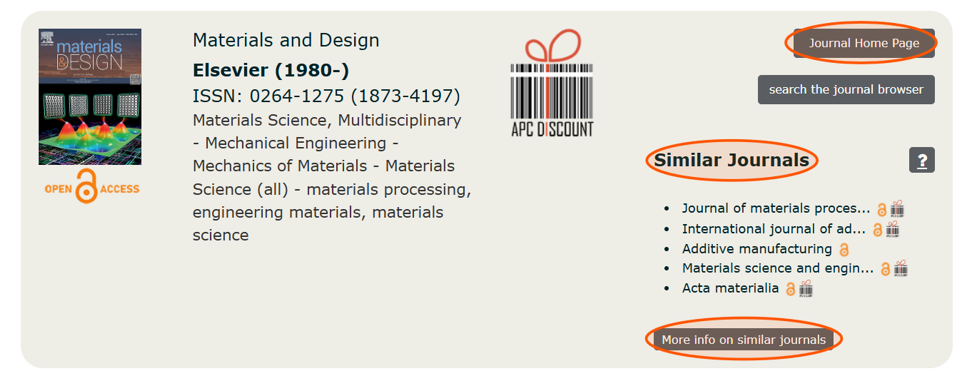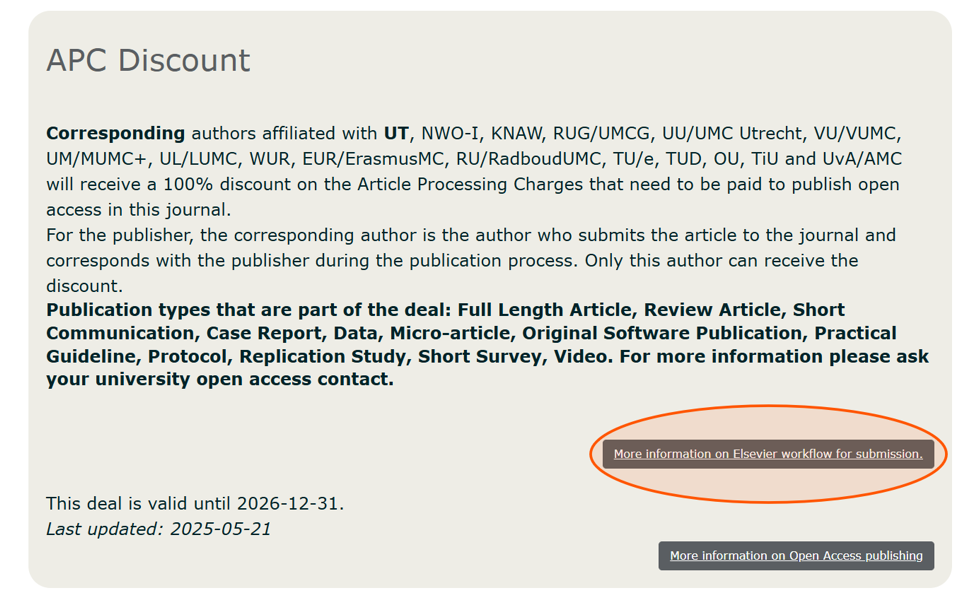The UT Journal Browser is a search engine with over 45,000 academic journals. It lets you find suitable journals in your field, and select journals that let you publish open access (OA) at no cost.
A journal is suitable for your research when its aims, scope, and intended audience match the work that you want to publish about. When you’re looking for a suitable journal in your field, always select Search all fields in the UT Journal Browser:

When you search in all fields, you will not only search for words in the journal’s title, but also in keywords that the journal uses to describe its aims and scope:

Click on a journal’s title for the journal’s individual page. On that page, click on Journal Home Page on the top right to find the journal’s aims and scope, author guidelines, and possible charges (e.g., so-called Article Processing Charges (APCs) for OA publishing, or page-excess charges that are not part of a possible discount agreement for OA publishing).

On the journal’s individual page, you’ll also see Similar Journals. These are the journals that were co-cited most often with this particular journal in UT-affiliated publications in the past three years. If journals are cited together often, then that’s an indication of similar aims and scope of these journals: these similar journals may also be suitable for your research. Click on More info on similar journals to find the 25 most similar journals. For each journal, only journals with 10 or more co-citations are shown.
When you scroll down on the journal’s individual page, you’ll see more information that may help you decide if this is a suitable journal for your research:
APC Discount
Submitting UT authors receive a full discount on the cost of OA publishing in over 10,000 journals. APC Discount shows the requirements for receiving such a discount. For more information, see the section ‘Selecting a journal that lets you publish open access at no cost’ below.
DOAJ info
The Directory of Open Access Journals (DOAJ) indexes peer-reviewed OA journals that meet the DOAJ criteria (e.g., for peer review and licensing). For more information, see How to check if a journal is trustworthy.
Green Open Access
This information tells you what you’re (not) allowed to do with your open or closed article in this journal. UT authors have an extra option: the UT’s opt-out procedure that leads to an open version of your originally closed paper in UT Research Information after six months.
Metrics
The University of Twente, as part of the Universities of the Netherlands (UNL), signed the Declaration on Research Assessment (DORA). In line with this declaration, use metrics wisely (e.g., do not use the Impact Factor to inform you about the quality of publications in this journal).
Do you have any questions or would you like some guidance in finding a suitable journal for your research? The information specialist(s) of your faculty will gladly help you.
If you’d like more info, then you can also follow the Nature Masterclass Choosing the Best Journal for Your Paper (free four-hour masterclass with a certificate at the end, through the UT’s institutional membership).
Journals often charge costs for OA publishing, but submitting UT authors can publish OA at no cost:
- in over 10,000 journals that let submitting UT authors publish OA at a 100% discount, and
- in over 13,000 high-quality OA journals in the Directory of Open Access Journals (DOAJ) that don’t charge costs for OA publishing.
In the UT Journal Browser, the open-access logo on the right indicates the type of journal:
- an orange logo (OPEN ACCESS) means that you automatically publish OA in this journal;
- a blue logo (OPEN REQUEST) means that you can choose to publish OA in this journal.

Underneath this logo, you’ll see discounts for UT authors. For instance, ‘100% APC discount for UT authors’ means that the journal offers a 100% discount on the cost of OA publishing (APC: Article Processing Charge) to submitting UT authors, if they meet the criteria described below. And ‘Probably no APC costs’ means that the last time it was checked, this journal didn’t charge costs for OA publishing, but always doublecheck before you submit your paper there.
To find out how to make use of a discount, click on the journal’s title and read the criteria underneath ‘APC Discount’. Then, click on ‘More information on [name publisher] workflow for submission’:

Important: make sure you’ll get the discount!
Most publishers only allow the submitting author, so the author who submits the article to the journal and corresponds with the publisher during the publication process, to receive the discount. That’s why you should always use your utwente email address when you submit your article, make sure that your affiliation on the article contains ‘University of Twente’, and when asked, indicate that you do want to publish open access. Have you already left the UT but are you publishing about UT research? Then ask a UT co-author to submit your joint article with their utwente email address to get the discount. You can still be the first author.
Important: make sure your article can be published open access!
More and more discount agreements use a cap; a maximum number of articles that can be published OA at the full discount each year. Once that cap is reached, authors need to pay to publish OA.
Before you submit your work – especially when you submit your work to an OA journal that publishes OA by default (with the orange open-access logo) or to a hybrid journal to request OA (with the blue open-request logo) – always doublecheck if you have backup funding in case the cap is reached before your article gets accepted for publication. You may be able to get funding from your funder (e.g., NWO, EU) or from your faculty in the case of BMS. Otherwise, your research group has to pay. If it’s an option for you to publish behind a paywall in a hybrid journal (with the blue open-request logo), then you can do so and use the UT’s opt-out procedure that leads to an open version of your originally closed paper in UT Research Information after six months.
If your research funder requires you to publish OA (e.g., funders that endorse Plan S), then always use the Rights Retention Strategy (RRS), even if you plan to publish in a journal with a discount agreement. If the agreement is not renewed, or the cap is reached, RRS lets you still comply with your funder’s requirements. Use the RRS when you first submit your article. That way, you can meet your funder’s requirements by making the accepted version of your article openly available in UT Research Information with a CC-BY licence, without an embargo, even if the published version ends up behind a paywall.
You can sign up for a notify-me service that will send you a maximum of two emails about the expected and final date that a cap will be reached. If you’re not sure if your article will get accepted in time to get the discount, please contact the information specialist of your faculty so you can look at your options together.